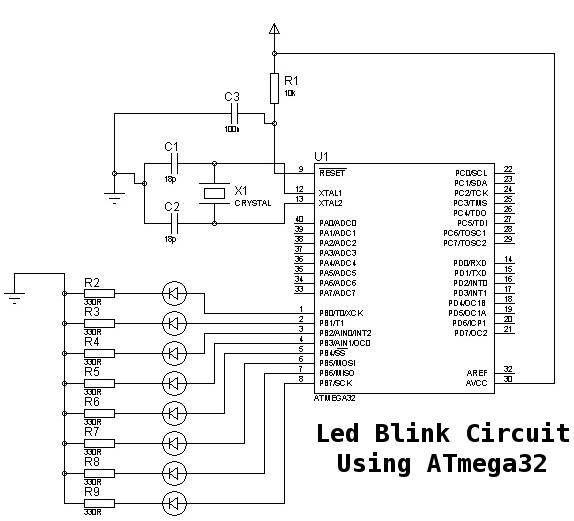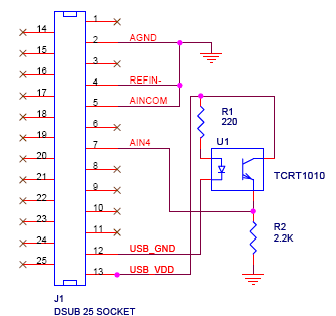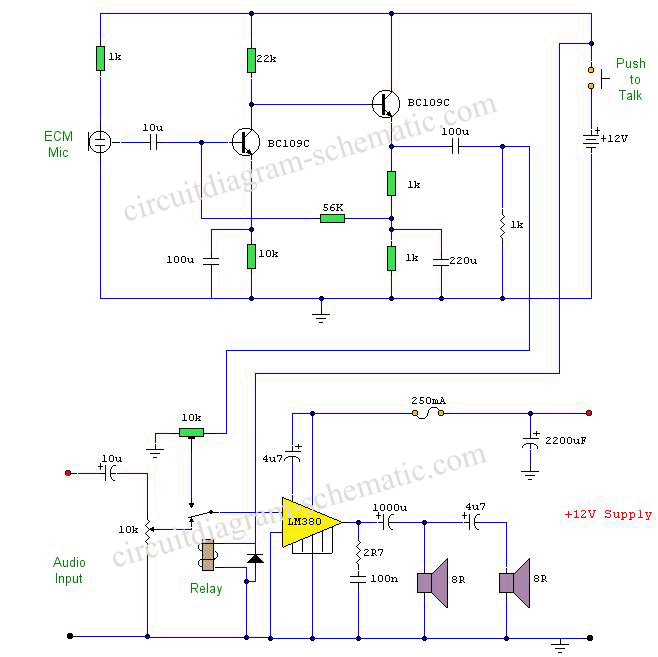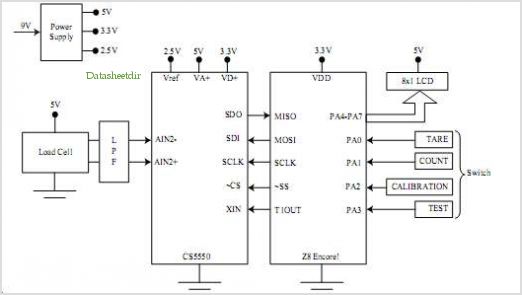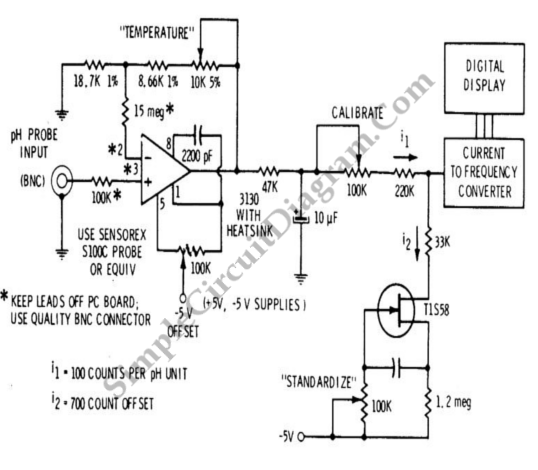
Full Duplex Digital Fiber Optic Voice Link
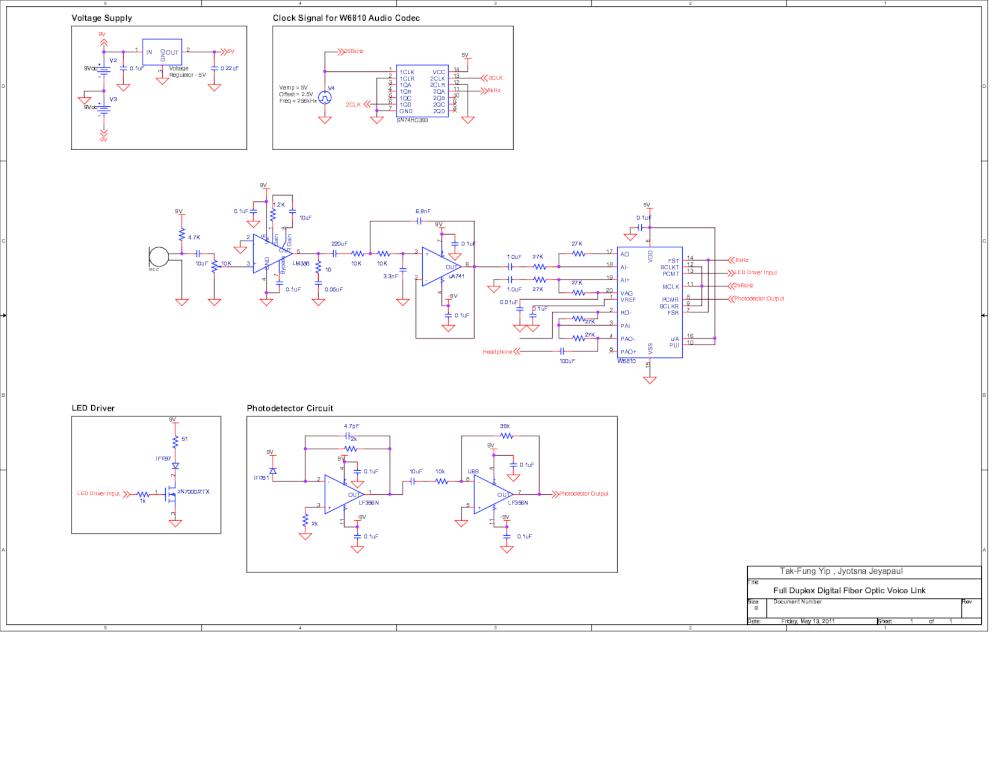
The objective of this project is to design and construct a full-duplex digital fiber optic voice link over a distance of 50 meters with a minimum data rate of 64 kbps. The key components of this project are the designs of the LED driver and photo-detector circuits. The provided circuit diagram illustrates one side of the circuit, while the other side is a duplicate of this configuration. It is important to note that the output from the LED driver is connected to the photo-detector circuit on the opposite side, and vice versa. The electret condenser microphone is powered with a 9V supply and a 4.7 kΩ load resistor, necessitating biasing due to the built-in FET amplifier within the microphone capsule. An AC-coupling capacitor is utilized as a high-pass filter to eliminate the DC offset, thus allowing the microphone signal to be AC-coupled. The audio amplifier in this design is tailored specifically for audio signals, rendering it unsuitable for general-purpose operational amplifiers. The circuit is sourced from the datasheet, providing a gain of 50. To mitigate signal distortion, a 10 kΩ potentiometer is incorporated for adjusting the amplitude of the input signal. Additionally, a 220 µF AC-coupling capacitor is employed to block DC offset. A second-order Sallen-Key low-pass filter is designed with a cut-off frequency of 3.5 kHz, which is adequate for human speech bandwidth. This specific filter is preferred over a standard RC filter due to its sharper roll-off and reduced noise. A 256 kHz clock signal is generated by a signal generator, serving as the master clock and bit clock for the audio encoder. An 8 kHz clock signal is derived from an SN54HC393 dual 4-bit binary counter, which divides the 256 kHz signal by 32. This 8 kHz clock signal synchronizes the transmission and reception of data bytes. The integrated circuit features an internal encoder and decoder, converting analog signals to digital form and vice versa. The circuit is designed according to the datasheet, which is configured for single-ended analog input and output. This configuration employs a typical LED driver using an N-channel MOSFET as a digital switch. The advantage of utilizing a MOSFET over a BJT or operational amplifier lies in its superior slew rate. After testing various MOSFETs, the 2N7000 was determined to have the best performance in terms of slew rate. In this setup, the LED is forward-biased and illuminates when the source side (input) of the MOSFET is HIGH. A high-speed photodiode detector is used to convert photons into electrical current, and in this scenario, the photodiode is reverse-biased to achieve a more linear load line. Subsequently, a trans-impedance amplifier transforms the current into voltage, which is further amplified by an inverting amplifier to yield an amplitude range of 0 to 5V. When selecting the operational amplifier for this circuit, the principle of maximizing the slew rate was maintained, as the gain of the op-amp is inversely proportional to the slew rate; thus, adjustments to the gain were made to prevent signal distortion resulting from low slew rates.
The project involves a detailed design of both the LED driver and photo-detector circuits, crucial for establishing a reliable fiber optic communication link. The LED driver circuit utilizes the 2N7000 MOSFET, which operates effectively as a switch, allowing for rapid modulation of the LED. This rapid switching capability is essential for transmitting digital signals across the fiber optic medium. The LED emits light when the MOSFET is activated, transmitting information encoded in the light signal.
On the receiving end, the photodiode is strategically reverse-biased to enhance its response time and linearity, which is vital for accurately detecting the incoming light signals. The trans-impedance amplifier is designed to convert the photocurrent generated by the photodiode into a voltage signal, which is then processed by an inverting amplifier to match the required output voltage levels. This amplification stage ensures that the signal remains within the desired range for subsequent digital processing.
The inclusion of a second-order Sallen-Key low-pass filter is a critical design choice, as it allows for effective attenuation of unwanted high-frequency noise while preserving the integrity of the audio signal. The filter's cut-off frequency is optimized for human speech, ensuring clear communication.
The synchronization of the data transmission is achieved through the use of clock signals generated by the SN54HC393 binary counter, ensuring that the audio data is correctly timed for both sending and receiving ends. This synchronization is essential for maintaining data integrity over the fiber optic link.
Overall, the design prioritizes performance, reliability, and clarity in audio transmission, making it suitable for applications requiring high-quality voice communication over fiber optic networks.The goal of this project is to design and build a full duplex digital fiber optic voice link over a length of 50m at minimum data rate of 64 kbps. The cores of this project are the designs of LED driver and photo-detector circuits. From the preceding circuit diagram, it only shows one side of the circuit. The other side of the circuit is just a du plicate from this circuit. The only part that you need to notice is the output of the LED driver is connected to the photo-detector circuit on the other side, and vice versa. The condenser microphone is biased with a 9V supply and a 4. 7k ohm load resistor. Recall that electret condenser microphone need biasing because of the built-in FET amplifier inside the microphone capsule.
The AC-coupling capacitor is used as a high pass filter to block the DC offset, so the microphone signal is AC coupling. Since this audio amplifier is built specifically for audio signal, so this amplifier can not be used as any other general-purpose op-amps.
This circuit here is used from the datasheet, which gives a gain of 50. In case of signal distortion, a 10K potentiometer is used to control the amplitude of the input signal. Again, the 220uF AC-coupling capacitor is used to block the DC offset. This second-order sallen-key low pass filter is designed to have a 3. 5kHz cut-off frequency, which bandwidth is sufficient for human speech. We used this specific filter over the typical RC filter because we obtain a sharper roll off and much less noise.
The 256kHz clock signal is generated by a signal generator, and it is mainly used as a master clock and bit clock for the audio encoder. The 8kHz clock signal obtained by using the SN54HC393 dual 4-bit binary counter, which divided the 256kHz signal by 32.
This 8kHz clock signal is used to synchronize the transmit data bytes and receive data bytes. This integrated circuit has an internal encoder and decoder that convert the analog signal to digital form, and digital to analog form respectively. This circuit is used from the datasheet, which is built for signal ended analog input and output. Again, this circuit is used from the datasheet. This is a typical LED driver using a N-channel MOSFET as a digital switch. The advantage of using MOSFET prior to BJT or Op-amp due to is the excellent slew rate. After testing with many different MOSFET, the 2N7000 has the best slew rate. Here, the LED is forward biased, and light on when the source side (input) of the MOSFET is HIGH. A high-speed photodiode detector is used to transduce the photon to electrical current. In this case, the photodiode is reverse-biased because the load line is much more linear. Next, the trans-impedance amplifier will convert the current into voltage, which will amplify again with an inverting amplifier so the amplitude is 0 to 5V.
When we were choosing the op-amp for this circuit, we had the same principle, which is the highest slew rate as possible. Since the gain of the op-amp is inverse proportion to the the slew rate, the gain must adjusted so it won`t affect the signal by the low slew rate.
🔗 External reference
The project involves a detailed design of both the LED driver and photo-detector circuits, crucial for establishing a reliable fiber optic communication link. The LED driver circuit utilizes the 2N7000 MOSFET, which operates effectively as a switch, allowing for rapid modulation of the LED. This rapid switching capability is essential for transmitting digital signals across the fiber optic medium. The LED emits light when the MOSFET is activated, transmitting information encoded in the light signal.
On the receiving end, the photodiode is strategically reverse-biased to enhance its response time and linearity, which is vital for accurately detecting the incoming light signals. The trans-impedance amplifier is designed to convert the photocurrent generated by the photodiode into a voltage signal, which is then processed by an inverting amplifier to match the required output voltage levels. This amplification stage ensures that the signal remains within the desired range for subsequent digital processing.
The inclusion of a second-order Sallen-Key low-pass filter is a critical design choice, as it allows for effective attenuation of unwanted high-frequency noise while preserving the integrity of the audio signal. The filter's cut-off frequency is optimized for human speech, ensuring clear communication.
The synchronization of the data transmission is achieved through the use of clock signals generated by the SN54HC393 binary counter, ensuring that the audio data is correctly timed for both sending and receiving ends. This synchronization is essential for maintaining data integrity over the fiber optic link.
Overall, the design prioritizes performance, reliability, and clarity in audio transmission, making it suitable for applications requiring high-quality voice communication over fiber optic networks.The goal of this project is to design and build a full duplex digital fiber optic voice link over a length of 50m at minimum data rate of 64 kbps. The cores of this project are the designs of LED driver and photo-detector circuits. From the preceding circuit diagram, it only shows one side of the circuit. The other side of the circuit is just a du plicate from this circuit. The only part that you need to notice is the output of the LED driver is connected to the photo-detector circuit on the other side, and vice versa. The condenser microphone is biased with a 9V supply and a 4. 7k ohm load resistor. Recall that electret condenser microphone need biasing because of the built-in FET amplifier inside the microphone capsule.
The AC-coupling capacitor is used as a high pass filter to block the DC offset, so the microphone signal is AC coupling. Since this audio amplifier is built specifically for audio signal, so this amplifier can not be used as any other general-purpose op-amps.
This circuit here is used from the datasheet, which gives a gain of 50. In case of signal distortion, a 10K potentiometer is used to control the amplitude of the input signal. Again, the 220uF AC-coupling capacitor is used to block the DC offset. This second-order sallen-key low pass filter is designed to have a 3. 5kHz cut-off frequency, which bandwidth is sufficient for human speech. We used this specific filter over the typical RC filter because we obtain a sharper roll off and much less noise.
The 256kHz clock signal is generated by a signal generator, and it is mainly used as a master clock and bit clock for the audio encoder. The 8kHz clock signal obtained by using the SN54HC393 dual 4-bit binary counter, which divided the 256kHz signal by 32.
This 8kHz clock signal is used to synchronize the transmit data bytes and receive data bytes. This integrated circuit has an internal encoder and decoder that convert the analog signal to digital form, and digital to analog form respectively. This circuit is used from the datasheet, which is built for signal ended analog input and output. Again, this circuit is used from the datasheet. This is a typical LED driver using a N-channel MOSFET as a digital switch. The advantage of using MOSFET prior to BJT or Op-amp due to is the excellent slew rate. After testing with many different MOSFET, the 2N7000 has the best slew rate. Here, the LED is forward biased, and light on when the source side (input) of the MOSFET is HIGH. A high-speed photodiode detector is used to transduce the photon to electrical current. In this case, the photodiode is reverse-biased because the load line is much more linear. Next, the trans-impedance amplifier will convert the current into voltage, which will amplify again with an inverting amplifier so the amplitude is 0 to 5V.
When we were choosing the op-amp for this circuit, we had the same principle, which is the highest slew rate as possible. Since the gain of the op-amp is inverse proportion to the the slew rate, the gain must adjusted so it won`t affect the signal by the low slew rate.
🔗 External reference

